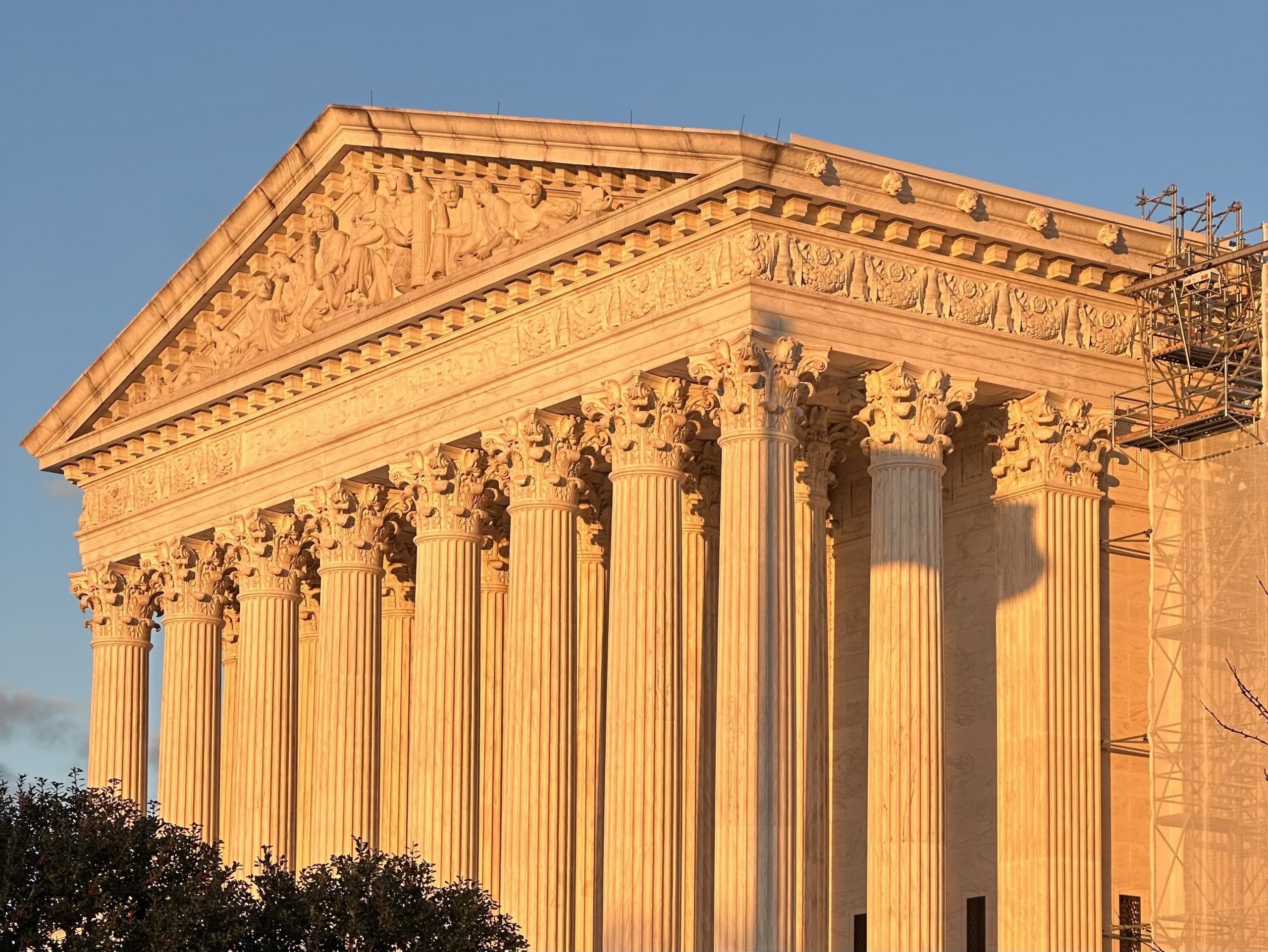Supreme Court to hear emergency abortion dispute out of Idaho
CASE PREVIEW
on Apr 23, 2024
at 4:32 pm
The justices will hear oral argument on Wednesday in the two consolidated cases brought by Idaho and its Republican legislature. (Katie Barlow)
Less than a month after the justices heard oral arguments in a case seeking to roll back access to one of the drugs used in medication abortions, the Supreme Court will hear oral arguments on Wednesday in another case involving abortion. At issue in Moyle v. United States and Idaho v. United States is whether emergency rooms in Idaho can provide abortions to pregnant women in an emergency. The Biden administration contends that a federal law known as the Emergency Medical Treatment and Labor Act can in some narrow circumstances trump a state law that criminalizes most abortions in the state. The state rejects the government’s interpretation of EMTALA as “an exercise of raw executive power,” while its Republican legislature condemns it as “an intolerable federal power grab.” They counter that the law does not require physicians to provide specific medical treatments, much less requires hospitals to perform abortions.
The case before the court on Wednesday began nearly two years ago in a federal court in Idaho. In the wake of the Supreme Court’s decision in Dobbs v. Jackson Women’s Health Organization, overturning the constitutional right to an abortion, the Biden administration argued that EMTALA – which requires emergency rooms that participate in Medicare to provide “necessary stabilizing treatment” – supersedes an Idaho law that makes it a crime to provide an abortion except in a handful of narrow circumstances, including to save the life of the mother or in cases of rape or incest.
U.S. District Judge B. Lynn Winmill agreed with the Biden administration. One day before the ldaho law was scheduled to take effect in late August 2022, he issued an order that prohibited Idaho from enforcing the ban to the extent that it conflicted with EMTALA. Over a dissent by four judges, the full U.S. Court of Appeals for the 9th Circuit rejected the state’s request to put Winmill’s ruling on hold while its appeal proceeded.
The state and its Republican-controlled legislature, which had joined the case to defend the law, then came to the Supreme Court, which in early January agreed to both put Winmill’s order on hold temporarily and to take up the case on the merits and hear oral argument.
In its brief in the Supreme Court, the legislature calls the suit “unprecedented,” arguing that the government’s interpretation rests on a “novel” theory that “denies States and the American people the freedom to chart their own course.” For its part, the state stresses that the “whole point of Dobbs was to restore to the states their authority to regulate abortion.”
Both the state and the legislature emphasize that EMTALA itself expressly provides that it does not trump any requirement imposed by state or local law “except to the extent that the requirement directly conflicts with a requirement” imposed by EMTALA. There is no such direct conflict here, they maintain, because EMTALA simply bars emergency rooms in hospitals that participate in Medicare from turning away lower-income patients. Instead, ERs must screen patients and stabilize them before transferring or discharging them. The law, the state argues, requires hospitals to provide this same emergency care to all patients, not only to pregnant patients but also to a patient’s “unborn child.”
The federal law does not, however, say anything about abortion or even require emergency rooms to provide any specific medical treatments. To the contrary, the legislature observes, the Medicare Act provides that federal officials will not “exercise any supervision or control over the practice of medicine or the manner in which medical services are provided.”
EMTALA addresses a patient’s treatment, the state maintains, only in the sense that it seeks to ensure that all patients are treated the same, regardless of their insurance coverage or socioeconomic status. Otherwise, the state tells the justices, “EMTALA operates within the menu of lawful treatments in a particular state and available at a particular hospital, requiring hospitals to offer stabilizing care from that menu. It neither authorizes nor requires hospitals to violate state law.”
But even if EMTALA did require ERs to provide specific medical treatments, the legislature continues, there would still not be a direct conflict between EMTALA and Idaho law. Testimony in the lower court indicated (but the district court ignored), the legislators say, that emergency room physicians would be able to provide care for virtually all of the emergency conditions that the government hypothesized, because the procedures that the patients would need would either be necessary to save their lives or would not be abortions at all.
The government’s interpretation of EMTALA as requiring ERs to provide abortions would both explicitly conflict with the Idaho statute’s goal of protecting the “unborn child,” and with federal laws that generally bar the use of federal funds for abortions unless the mother’s life is endangered or in cases of rape or incest. “It is nonsensical,” the state writes, “to assume that Congress required the very thing it prohibits using federal dollars to fund.”
Interpreting EMTALA to require hospitals to provide emergency care that sometimes includes abortions is also inconsistent, the state and the legislature argue, with the “major questions” doctrine – the idea that if Congress intends to give a federal agency the power to make decisions with vast economic or political significance, it must say so clearly. EMTALA, the legislators say, does not say anything about abortion, much less serve as “HHS’s Trojan horse” allowing the Biden administration to have “the final word on the availability of abortion in most hospitals nationwide.” Instead, the legislators say, Congress and the states should be able to make those kinds of decisions. This is particularly true given the stakes of the Biden administration’s interpretation: Medicare spending in Idaho, where one in five residents is enrolled in the program, was $3.4 billion in the two-year period between 2018 and 2020, while annual Medicare spending in 2022 was nearly a trillion dollars.
And although the Constitution does allow the government to impose conditions on the recipients of federal funds, those conditions only apply when the recipients voluntarily agree to them – which the hospitals may have done in this case, by entering into Medicare contracts, but Idaho did not. Moreover, the legislators add, the penalty that the government has threatened for hospitals that do not provide abortions would be an “outsized penalty” that would “create a financial and public-health crisis in Idaho and the many other States that have returned to regulating abortion since Dobbs.”
The Biden administration emphasizes that the question before the court is a “narrow” one that “does not involve whether States can prohibit abortion generally” but instead focuses on whether states “can deny pregnant women essential medical care to prevent grave harm to their health notwithstanding EMTALA’s stabilization mandate.” Although that question is “profoundly important for pregnant women and the providers who treat them in emergencies,” U.S. Solicitor General Elizabeth Prelogar acknowledges, “it is a discrete question of statutory interpretation that arises only in rare circumstances and does not broadly implicate the national debate on abortion policy.’
The government depicts EMTALA as serving a very different purpose than the state and the legislature suggest. Rather than merely preventing patient dumping, it contends, the law “promises essential emergency care to all Americans.” This means, the government writes, that when a pregnant woman “experiences an emergency medical condition that makes continuing the pregnancy a grave threat to her life or health, pregnancy termination is essential medical care.”
The federal government, it notes, has long interpreted EMTALA to require hospitals to offer abortions as stabilizing treatment, dating back to the George W. Bush administration. But until the court’s decision in Dobbs, there was no conflict between that interpretation and state law, the government explains, because states could generally not bar abortions. And even now, most other state laws restricting abortion contain exceptions allowing health-care providers to end a pregnancy when necessary to avoid serious harm to the health of the pregnant women.
The text of EMTALA makes clear that it trumps state law only when the state law “directly conflicts” with EMTALA, the government reasons. So although Idaho can enforce almost all of its law restricting abortion, the government asserts, the state “cannot prohibit the emergency care that federal law requires in the narrow circumstances covered by EMTALA.” Specifically, the government continues, Idaho’s law bars the termination of a pregnancy unless it is “necessary to prevent the death of a pregnant woman.” But, as the district court concluded, the government explains, EMTALA could require the termination of a pregnancy as stabilizing treatment to prevent serious harm to the woman’s health (but not her death) in several scenarios in which providing an abortion would be a felony under Idaho law – for example, the rupture of the amniotic sac or the placenta, an uncontrollable uterine hemorrhage, or preeclampsia.
The government pushes back against the suggestion by the state and the legislature that EMTALA merely bars emergency rooms from turning away patients and does not require specific kinds of treatments. That argument, the government insists, is inconsistent with the text of EMTALA, which expressly requires participating hospitals to provide “any individual” with an emergency medical condition “such treatment as may be required to stabilize the medical condition.”
Similarly, the government continues, there is no merit to the state’s contention that EMTALA cannot require states to provide stabilizing treatment that is barred by state law because such care would not be “within the staff and facilities available at the hospital,” as federal law requires. The text of EMTALA, the government argues, “refers to physical and personnel constraints. It cannot plausibly be read as a cryptic incorporation of state law.”
Under any of the interpretations offered by the state and the legislature, the government posits, EMTALA could never preempt state laws regulating abortion, no matter how restrictive they were. “That means a pregnant women could arrive at a hospital urgently needing essential care and, instead of offering ‘such treatment as may be required to stabilize the medical condition,’ the hospital would have to let her die. EMTALA’s stabilization mandate cannot be such an empty promise,” the government cautions.
The government also emphasizes that Congress has broad power to decide what conditions it will place on the receipt of federal funds. Hospitals that want to participate in Medicare and Medicaid have traditionally been required to “satisfy a host of conditions that address the safe and effective provision of healthcare,” it contends. The government thus rejects the legislature’s argument that Congress cannot rely on its spending power to force states to disregard their laws when the states have not voluntarily agreed to do so. Congress, the government insists, “is not commanding Idaho to do anything; the funding recipients are the hospitals, not the State.”
The government also pushes back against the challengers’ suggestion that the government’s interpretation violates the major questions doctrine. This case, the government emphasizes, is not about the authority that Congress gave to the Department of Health and Human Services, but instead the decisions made by Congress itself in EMTALA to require hospitals to provide stabilizing treatment in an emergency. “The mere fact that a question of statutory interpretation is consequential or controversial has never been a reason to put a thumb on one side of the interpretive scale,” the government concludes, particularly when the executive branch, Congress, and the courts have all shared this understanding of EMTALA “for nearly four decades.”
This article was originally published at Howe on the Court.






